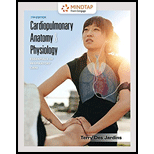
Concept explainers
Introduction:
Sleep is defined as a partial state of natural unconsciousness in humans. It can be categorized on the basis of the pattern of the brain waves and the activity of the neurons involved. The two types of sleep patterns observed in human beings are rapid eye movement (REM) sleep and non-rapid eye movement sleep (NREM), which is based on the mobility of the eye and muscular activity of the body.
Answer to Problem 1RQ
Correct answer:
REM sleep.
Explanation of Solution
Justification/ Explanation for the correct answer:
Option (e) is, ‘REM sleep.’ Paradox sleep is also known as REM sleep. The REM sleep pattern is observed by studying the electrical activity of the brain using electroencephalogram (EEG). The EEG reveals that the pattern of the brain waves in REM sleep is similar to the awakened state. Irregular diaphragm activity, breathing rate, and heart rate are observed in this type of sleep. The skeletal muscles activity is greatly reduced, thus a sense of paralysis is felt by the sleeper. Hence, option (e) is correct.
Explanation for the incorrect answer:
Option (a) is, ‘stage N1 non-REM sleep.’ The stage N1 non-REM sleep pattern shows that the muscular activity is decreased, slow rolling eye movement is observed, the heart rate is reduced, and the respiratory pattern is regular. This stage is the lightest stage of sleep and the skeletal muscle activity is not reduced by much extent, thus sleep paralysis does not occur. So, it is an incorrect option.
Option (b) is, ‘stage N2 non-REM sleep.’ The stage N2 non-REM sleep is also a form of light sleep in which major
Option (c) is, ‘stage N3 non-REM sleep.’ The stage N3 non-REM sleep is also known as deep sleep. It is the stage of least consciousness in humans as the brain activity and the muscular
movement are severely reduced in this stage. Although the skeletal muscle activity is reduced severely, the sleeper does not feel sleep paralysis as the self-awareness level is low. Thus, sleep paradox cannot occur. So, it is an incorrect option.
Option (d) is, ‘stage W (wake).’ The stage W has a similar EEG pattern to the REM sleep, although the movement of eyes in this type stage is much lower and the activity of the brain is similar to REM. The individual is partially conscious and alert of its external stimuli and the skeletal muscle activity is moderate. Thus, sleep paradox cannot occur. So, it is an incorrect option.
Hence, options (b), (c), and (d) are incorrect.
Therefore, it can be concluded that sleep paradox is a state of partial consciousness where the sleep is aware of its surroundings but is unable to perform any physical movements. This occurs during the REM stage of sleep due to high brain activity but a reduced muscular activity, which leads to a feeling of paralysis as the sleeper transits from sleep to wake form.
Want to see more full solutions like this?
Chapter 17 Solutions
MindTap for Des Jardins' Cardiopulmonary Anatomy & Physiology, 2 terms Printed Access Card
- Molecular Biology Question A gene that codes for a protein was removed from a eukaryotic cell and inserted into a prokaryotic cell. Although the gene was successfully transcribed and translated, it produced a different protein than it produced in the eukaryotic cell. What is the most likely explanation?arrow_forwardMolecular Biology LIST three characteristics of origins of replicationarrow_forwardMolecular Biology Question Please help. Thank you For E coli DNA polymerase III, give the structure and function of the b-clamp sub-complex. Describe how the structure of this sub-complex is important for it’s function.arrow_forward
- Molecular Biology LIST three characteristics of DNA Polymerasesarrow_forwardMolecular Biology RNA polymerase core enzyme structure contains what subunits? To form holo enzyme, sigma factor is added to core. What is the name of the structure formed? Give the detailed structure of sigma factor and the function of eachdomain. Please help. Thank youarrow_forwardMolecular Biology You have a single bacterial cell whose DNA is labelled with radioactiveC14. After 5 rounds of cell division, how may cells will contain radioactive DNA? Please help. Thank youarrow_forward
- 1. Explain the structure and properties of atoms and chemical bonds (especially how they relate to DNA and proteins). Also add some pictures.arrow_forward1. In the Sentinel Cell DNA integrity is preserved through nanoscopic helicase-coordinated repair, while lipids in the membrane are fortified to resist environmental mutagens. also provide pictures for this question.arrow_forwardExplain the structure and properties of atoms and chemical bonds (especially how they relate to DNA and proteins). Also add some pictures.arrow_forward
- In the Sentinel Cell DNA integrity is preserved through nanoscopic helicase-coordinated repair, while lipids in the membrane are fortified to resist environmental mutagens. also provide pictures for this question.arrow_forward1. Explain how genetic information is stored, copied, transferred, and expressed. Also add some pictures for this question.arrow_forward!. Describe biological macromolecules (DNA, RNA, proteins, lipids, etc.) and how they function in the cell. also provide some images for this question.arrow_forward
 Cardiopulmonary Anatomy & PhysiologyBiologyISBN:9781337794909Author:Des Jardins, Terry.Publisher:Cengage Learning,
Cardiopulmonary Anatomy & PhysiologyBiologyISBN:9781337794909Author:Des Jardins, Terry.Publisher:Cengage Learning, Comprehensive Medical Assisting: Administrative a...NursingISBN:9781305964792Author:Wilburta Q. Lindh, Carol D. Tamparo, Barbara M. Dahl, Julie Morris, Cindy CorreaPublisher:Cengage Learning
Comprehensive Medical Assisting: Administrative a...NursingISBN:9781305964792Author:Wilburta Q. Lindh, Carol D. Tamparo, Barbara M. Dahl, Julie Morris, Cindy CorreaPublisher:Cengage Learning Human Physiology: From Cells to Systems (MindTap ...BiologyISBN:9781285866932Author:Lauralee SherwoodPublisher:Cengage Learning
Human Physiology: From Cells to Systems (MindTap ...BiologyISBN:9781285866932Author:Lauralee SherwoodPublisher:Cengage Learning Concepts of BiologyBiologyISBN:9781938168116Author:Samantha Fowler, Rebecca Roush, James WisePublisher:OpenStax College
Concepts of BiologyBiologyISBN:9781938168116Author:Samantha Fowler, Rebecca Roush, James WisePublisher:OpenStax College





